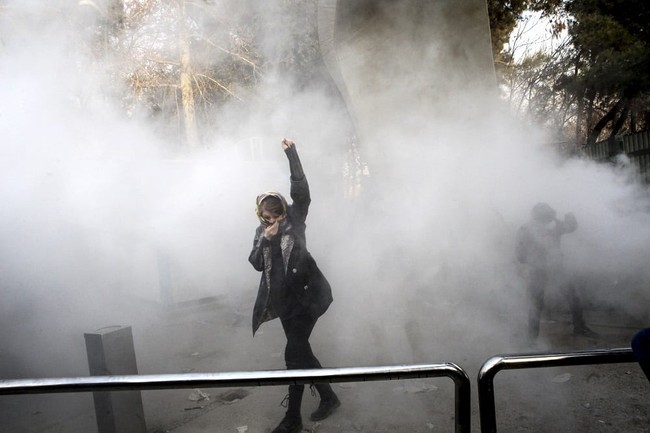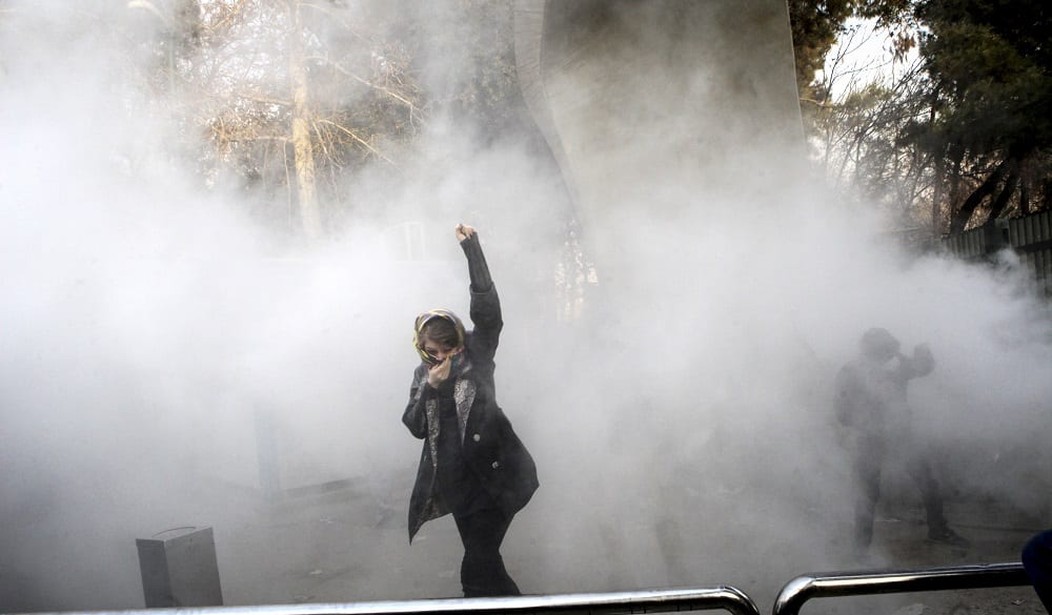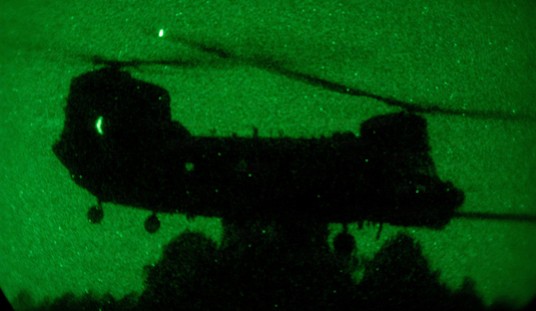
In this photo taken by an individual not employed by the Associated Press and obtained by the AP outside Iran, a university student attends a protest inside Tehran University while a smoke grenade is thrown by anti-riot Iranian police, in Tehran, Iran, Saturday, Dec. 30, 2017. A wave of spontaneous protests over Iran’s weak economy swept into Tehran on Saturday, with college students and others chanting against the government just hours after hard-liners held their own rally in support of the Islamic Republic’s clerical establishment. (AP Photo)
The late novelist, Michael Crichton, described a mental condition that he called Gell-Mann Amnesia. It was named for the Nobel Prize winning physicist Murray Gell-Mann (but you didn’t need to know that to understand what Crichton was talking about):
Briefly stated, the Gell-Mann Amnesia effect works as follows. You open the newspaper to an article on some subject you know well. In Murray’s case, physics. In mine, show business. You read the article and see the journalist has absolutely no understanding of either the facts or the issues. Often, the article is so wrong it actually presents the story backward-reversing cause and effect. I call these the “wet streets cause rain” stories. Paper’s full of them. In any case, you read with exasperation or amusement the multiple errors in a story-and then turn the page to national or international affairs, and read with renewed interest as if the rest of the newspaper was somehow more accurate about far-off Palestine than it was about the story you just read. You turn the page, and forget what you know.
If you’ve ever served a day in the military or have any life experience about anything you have encountered this. And, for reasons that are unclear to me, we still fall for the schtick.
Yesterday and today have seen Iran rocked by widespread riots. While Ben Rhodes’ Echo Chamber is trying to either ignore the story or cobble together a case that it is about the economy, what we are seeing there is quite different. There is significant dissatisfaction with the government and the chants lead one to believe that a lot more Iranians are being killed in Iraq and Syria than anyone has heretofore imagined.
Scattered Protests Erupt in Iran Over Economic Woes. https://t.co/waB6Qrn2NC
— Thomas Erdbrink (@ThomasErdbrink) December 30, 2017
These demonstrations didn’t just happen. They obviously represent a long simmering resentment at corruption and repression in daily life. So how did the New York Times cover this last month (same reporter as the tweet above)?
Long Divided, Iran Unites Against Trump and Saudis in a Nationalist Fervor
After years of cynicism, sneering or simply tuning out all things political, Iran’s urban middle classes have been swept up in a wave of nationalist fervor.
The changing attitude, while some years in the making, can be attributed to two related factors: the election of President Trump and the growing competition with Saudi Arabia, Iran’s sectarian rival, for regional dominance.
Iranians listened during the 2016 campaign as Mr. Trump denounced the Iran nuclear treaty as “the worst deal ever negotiated” and promised to tear it up. They watched in horror when, as president, he sold more than $100 billion worth of weapons to the kingdom of Saudi Arabia and participated in a traditional war dance in Riyadh. And they are alarmed at the foreign policy moves of the young Saudi crown prince, Mohammed bin Salman, whom they see as hotheaded and inexperienced.
At the same time, they now believe they have something to be proud of, with Iranian-led militias playing a central role in defeating the Islamic State militant group in Syria and Iraq, increasing Iran’s regional influence in the process.
The two most popular stars in Iran today — a country with thriving film, theater and music industries — are not actors or singers but two establishment figures: Gen. Qassim Suleimani, the leader of Iran’s regional military effort, which is widely seen as a smashing success; and the foreign minister, Mohammad Javad Zarif, the symbol of a reasonable and measured Iran.
In short, it appears that Mr. Trump and the Saudis have helped the government achieve what years of repression could never accomplish: widespread public support for the hard-line view that the United States and Riyadh cannot be trusted and that Iran is now a strong and capable state capable of staring down its enemies.
This could have come from someone who was the moral successor of Walter Duranty writing about Ukraine.
In retrospect, it is pretty easy to recognize this for what it is. Propaganda. Propaganda put out by former Obama administration goons to journalists who might as well be on the payroll. Propaganda in service of the #Resistance. No, the demonstrations in Iran are not about the economy.
Demonstrators shout “We don’t want an Islamic republic!” #IranianProtests #IranUprising #Heroes pic.twitter.com/VqOO26OTpZ
— Andy Ngô (@MrAndyNgo) December 30, 2017
BBC video from a small town Abhar, Iran shows protestors taking down Iran Supreme Leader’s banner pic.twitter.com/7ieZIzB00R
— Ragıp Soylu (@ragipsoylu) December 30, 2017
In a "first" for #IranProtests, demonstrators chant "Death to Revolutionary Guards!" in city of Rasht pic.twitter.com/cLyq9stz4H
— Josh Caplan (@joshdcaplan) December 30, 2017
Mujer iraní desafía a la policía y se quita el hijab en un acto de protesta contra el régimen. #Irán pic.twitter.com/b02UPQgwiV
— @damianpachter (@damianpachter) December 30, 2017
This is not about Trump, beyond the people realizing that the US government is no longer working hand-in-glove with the Iranian regime. This is not about nationalistic fervor over the fate of some terrorist-wannabe who met a well-deserved end at the hands of other terrorists. This is about a rejection of the regime in Tehran and a rejection of Obama’s entire premise for the Iran nuclear deal.













Join the conversation as a VIP Member